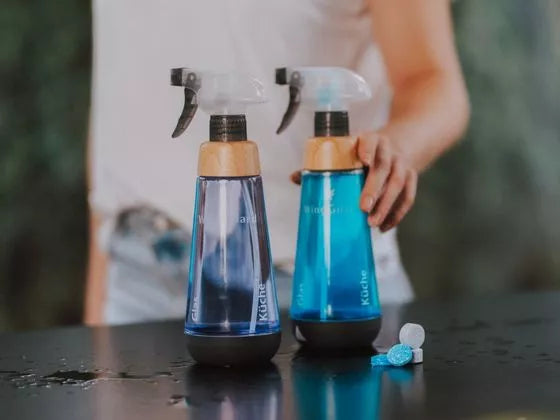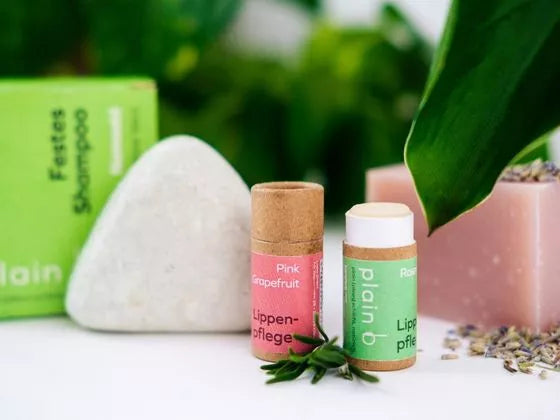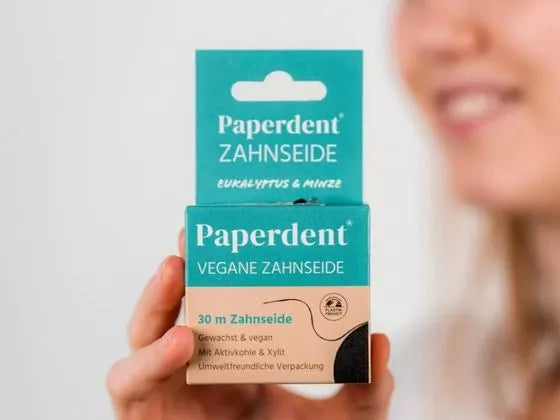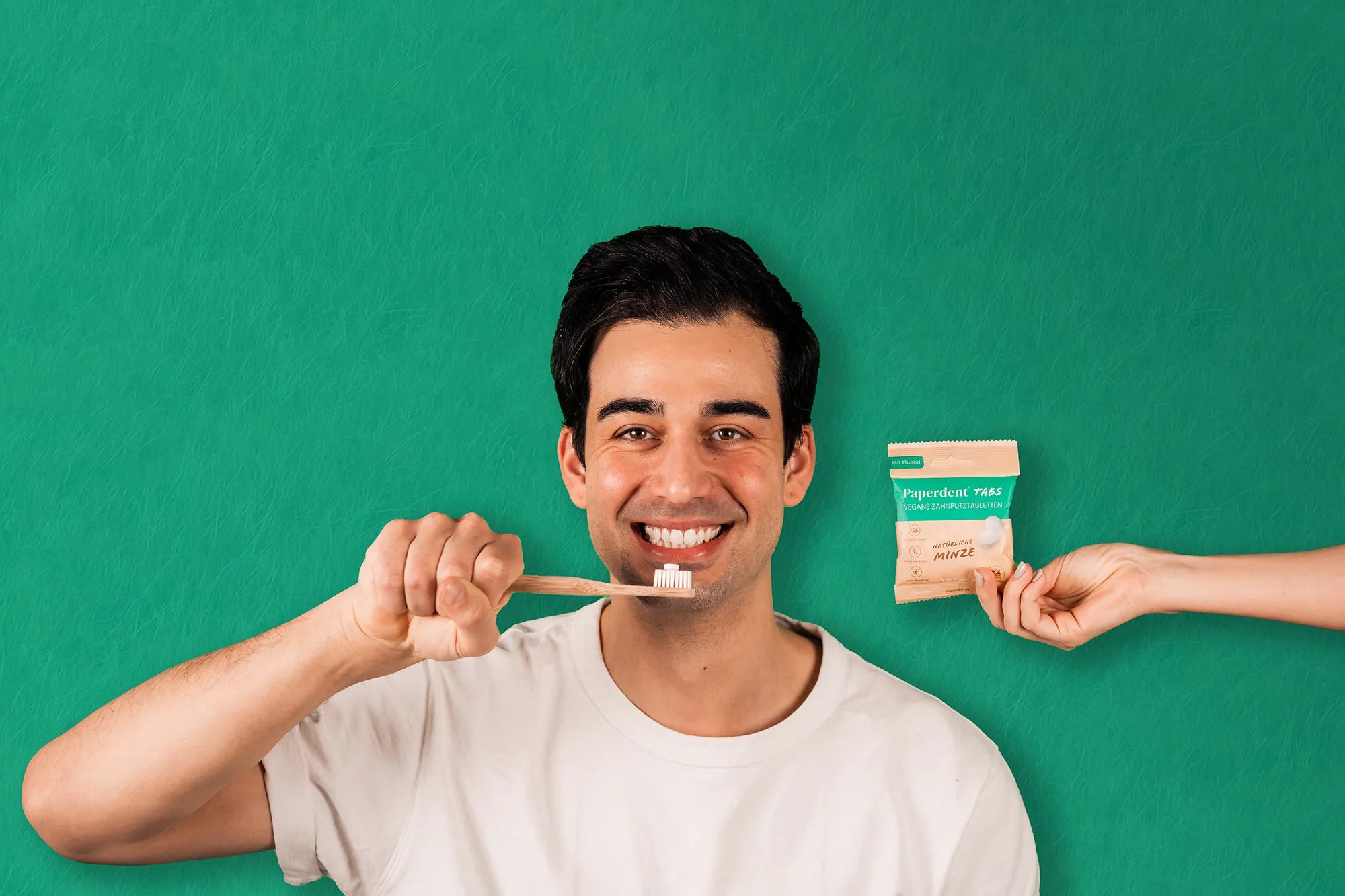Our products
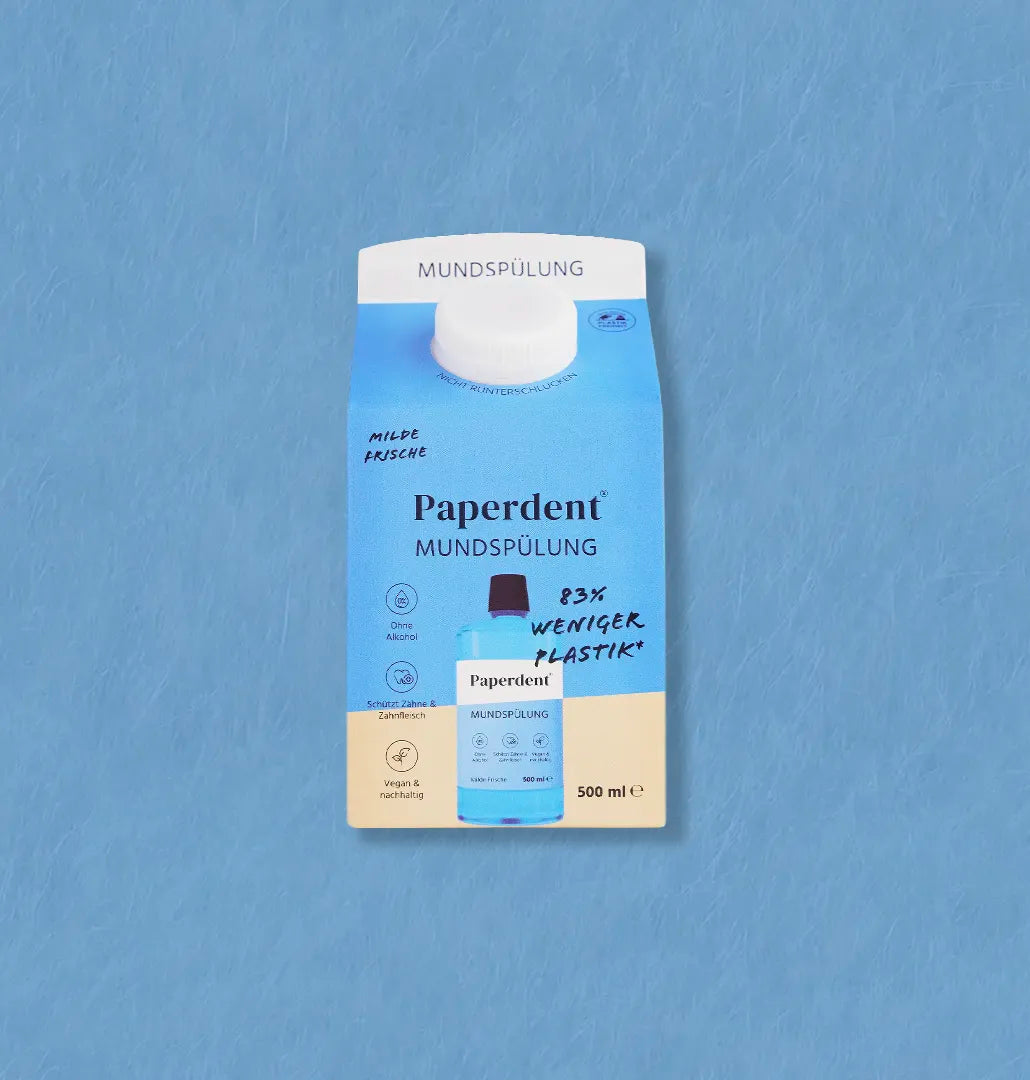
Mouthwash
With the Paperdent mouthwash you get a 6-fold protection for your dental care routine. Its gentle taste leaves a long-lasting feeling of freshness and protects your teeth and gums from bacteria, tooth decay and tartar. Our mouthwash contains no alcohol and is completely vegan.
But we don't just focus on the content. We attach just as much importance to our packaging: That is why the packaging of our Paperdent mouthwash is environmentally friendly and ensures the lowest possible impact on our environment. With Paperdent you are not only doing something good for your oral health, but also for our environment.
FAQ's Mouthwash
Using a mouthwash is the perfect complement to daily brushing. It can help prevent tooth decay, protects against gingivitis and helps against bad breath.
It is best to rinse your mouth out once or twice a day after brushing your teeth for 30 seconds with about 20 ml of the mouthwash. Then spit out the mouthwash and do not swallow it.
The packaging of the Paperdent mouthwash contains 7 g of plastic. That's around 83% less plastic than conventional mouthwash bottles. The rest of the packaging consists mainly of cardboard that comes from FSC-certified wood cultivation. Thanks to this renewable resource, the ecological footprint is particularly small. In addition, the fibers of the cardboard can be recycled very easily. In special recycling plants in Germany it is also possible to recycle the plastic from the inner coating.
In order to dispose of the packaging in the best possible way, throw the box including the lid into the yellow sack. This will ensure that everything is properly disposed of and recycled.
The recyclability of the mouthwash packaging is around 80%. However, there are some specialized recycling plants in Germany that can recycle almost 100% of the cardboard. To do this, the cardboard is first separated from the inner coating, which is possible without any chemicals. The separated fibers can be recycled up to 6 times and are used in a variety of products.
For example, they are used for the production of pizza boxes, envelopes, corrugated cardboard or egg cartons. The other materials can also be recycled. For example, the closure and inner liner plastic can be used in film manufacturing and injection molding applications. The aluminum obtained (which we would like to do without in our packaging in the future) is used in the paint and building materials industry.
In order for the mouthwash to take full effect, you should wait about 30 minutes before drinking and eating.
You can also use a mouthwash in between. However, if you want to incorporate the mouthwash into your fixed dental hygiene routine, it is best to use it after brushing your teeth.
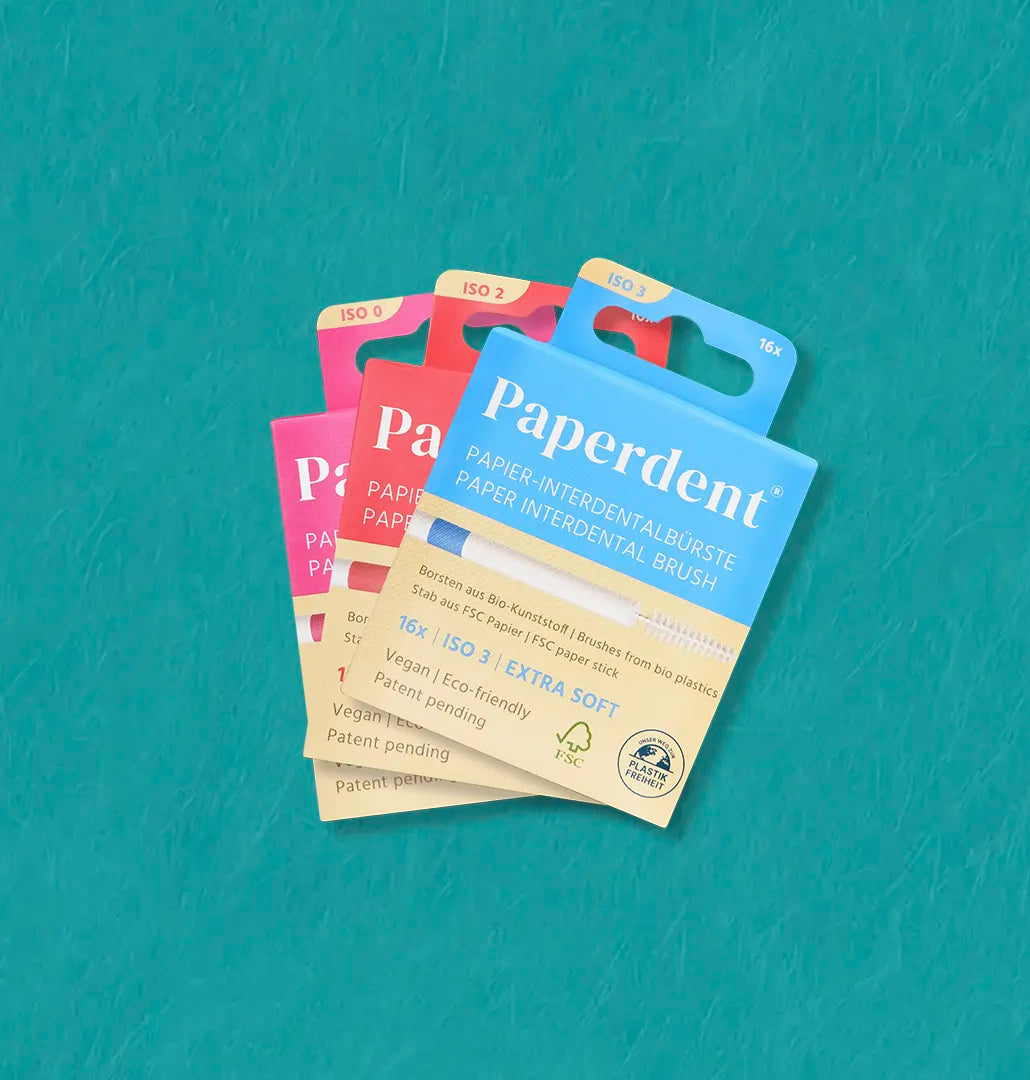
Interdental brushes
When developing our Paperdent paper interdental brush, we not only focused on cleaning your interdental spaces, bridges or braces, but also on sustainability. We know that the short lifespan of interdental brushes shouldn't be a reason to create mountains of plastic waste. For this reason, the handle of our interdental brush is made of FSC-certified paper.
The flexible brush head of our interdental brush is made of high-quality, rustproof stainless steel and has castor oil filaments. These materials enable thorough cleaning of your interdental spaces, bridges or braces. With the Paperdent interdental brush, you not only get effective cleaning, but also make a sustainable contribution to protecting our environment.
FAQs interdental brush
Interdental brushes are used to clean the space between the teeth and as a supplement to daily tooth cleaning. It is precisely these places that your toothbrush can only reach with great difficulty or not at all. By cleaning the spaces between your teeth with interdental brushes, you prevent gingivitis, tooth decay and the formation of plaque.
It is best to use the interdental brush in the evening before brushing your teeth. To do this, insert the interdental brush carefully and at a slight angle into each interdental space at the gum line and move the brush back and forth several times. Rinse the brush under running water after each gap so that plaque or food particles are washed away. Then store the brush in a clean and dry place. As soon as the bristles are worn out or snap off, you should replace the interdental brush.
So that the spaces between your teeth can be cleaned as efficiently as possible, it is important that you choose the right size. You can tell the right size by the fact that you have to apply light pressure to insert the interdental brush into the space. However, it should never be pushed in with force, otherwise you could injure your gums. If you don't notice any resistance at all, the interdental brush is too small and the cleaning result is not optimal. In most cases, however, you need different brush sizes, since not all spaces between the teeth are the same size. Your dentist can advise you on choosing the right size.
Once you start using interdental brushes, or only do it very infrequently, you may occasionally experience bleeding gums. This can be due to small inflammations and irritations. However, if your gums bleed after each cleaning with the interdental brush, you should clarify the cause with your dentist.
Even with a bridge, it is possible to clean the interdental spaces with interdental brushes. It is used in exactly the same way as with natural teeth: the interdental brush is carefully inserted between the teeth at the gum line and carefully moved back and forth. Rinse the brush under running water after each gap so that plaque or food particles are washed away. Then store the brush in a clean and dry place. As soon as the bristles are worn out or snap off, you should replace the interdental brush.
With braces, the spaces between the teeth can also be cleaned with interdental brushes. The area between the teeth can be cleaned, but also where it is not possible to use dental floss, for example below the wire. Implants should be cleaned just as thoroughly as your own teeth, which can also be done with interdental brushes.
If the paper handle did not come into contact with the saliva, you can cut it off and dispose of it in the paper waste. Otherwise, the paper handle can be disposed of with the residual waste together with the brush head.
An interdental brush can be reused several times. However, for hygienic reasons, you should replace the brushes after one to two weeks at the latest. At the latest, however, as soon as the bristles are worn out or snap off.
You should clean the spaces between your teeth once a day, preferably in the evening before brushing your teeth. The detached plaque is then brushed out of the interdental space with the toothbrush in this order.
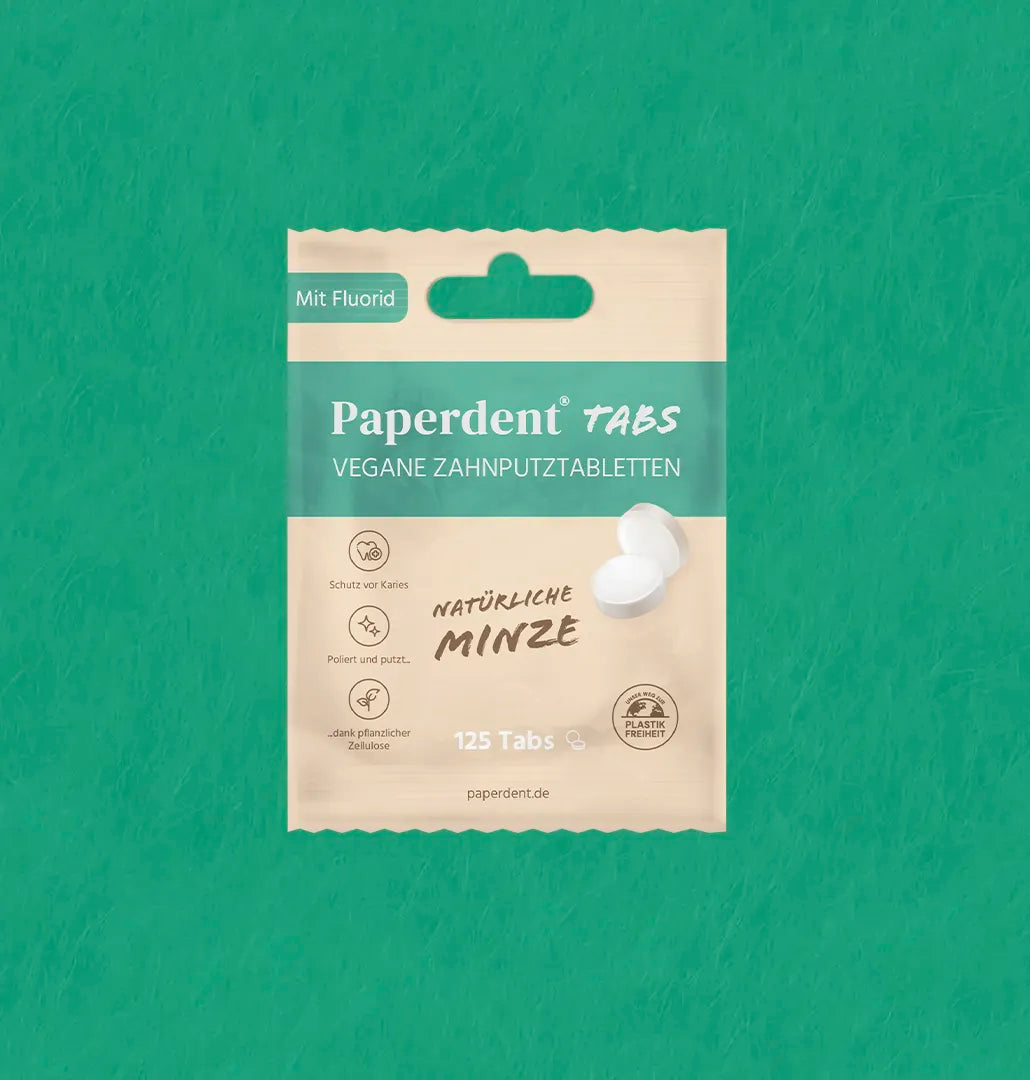
Toothbrush tabs
Dental hygiene is an important part of daily oral care. For this reason, we at Paperdent have developed our toothbrush tablets, which care for and polish your teeth particularly effectively and sustainably due to the high proportion of vegetable cellulose. The natural mint aroma provides a refreshing feeling after brushing your teeth.
Our anhydrous Paperdent Tabs have a proven, unique fluoride effect in the mouth that provides long-term protection against tooth decay. Our toothpaste tablets were developed in cooperation with dentists and contain no preservatives. They are also completely microplastic-free and vegan.
FAQs toothbrush tabs
That's no problem. Of course you can also use our tooth cleaning tabs with braces. However, it is possible that your saliva will be darker in color when you spit it out. The reason is that the polishing effect of the cellulose fibers removes deposits from the wires and brackets.
Our tooth cleaning tabs are also suitable for people with dentures. The principle of polishing also works without any problems on crowns, bridges and inlays. The tooth cleaning tabs even polish removable dentures. However, please only use it on the visible areas.
We recommend 1 tablet in the morning and 1 tablet in the evening. In order to slowly approach the foam-free cleaning experience, you can also start with 2 tablets in the morning and in the evening. If you feel like freshening your breath during the day, you can also chew a tablet in between and rinse your mouth with water.
Cleaning with the Paperdent Tabs is unusual at first, but basically very simple:
- You take 1 tablet in your mouth and chew it up, eg with your molars. This results in a creamy consistency, not a foamy one. We deliberately only use a very gentle and natural surfactant in our tabs.
- You wet your toothbrush and brush your teeth as usual.
- Finally, rinse your mouth out with water. Complete!
In general, dental care products should have two functions to protect against tooth decay:
- A high bioavailability of fluoride ions in the saliva for remineralization.
- Efficient plaque removal with gentle abrasiveness (sanding effect).
Both have been proven with the toothbrush tabs in numerous studies and laboratory tests.
Added to this is the gentle polish provided by the cellulose fibers it contains. This removes superficial discolouration from coffee, nicotine or other foods. In addition, the polish creates a particularly smooth tooth surface, which makes it difficult for new plaque to adhere. This is how our toothbrush tabs provide wonderful protection against tooth decay.
We source the cellulose through our partner from FSC-certified forests in Sweden. This secures the biodiversity, the water content and the water quality of the soil, as well as the CO₂ storage capacity and the continued existence of the forest.
In order to guarantee that the tabs stay fresh for a long time, you should fill them into an airtight container and store them after opening.
The tabs themselves are of course free of microplastics. However, the Paperdent packaging consists of 45% paper and 55% inner bio-foil. The bio-foil consists of a polymer layer consisting of 63% polylactide (PLA, based on corn starch) and 37% the polymer polybutylene adipate terephthalate (PBAT).
Both PLA and PBAT are biodegradable and industrially compostable. This means that the packaging has been shown to degrade under certain industrial conditions (temperature, humidity and oxygen supply). The Paperdent packaging is therefore also certified for industrial compost, ie it has been proven that up to 90% of it decomposes under the required composting conditions in industrial compost.
Strictly speaking, the packaging is not plastic-free, as it contains 1.2 g of the degradable polymer film as described above. But we are already working on an even more ecological variant.
The packaging of our toothbrush tabs has so far only been industrially compostable. However, this does not mean that the packaging can go in the organic waste bin. Unfortunately, the German disposal system is not yet designed for this. Until then, you should put the Paperdent packaging in the yellow bin so that it can be properly recycled.
And it is important that you do not have to do without anything when you switch to more sustainable dental care products. Fluoride remineralizes and hardens tooth enamel, protecting teeth from acid and tooth decay. That is why you will also find the recommended amount of 1450 ppm fluoride in our toothbrush tabs.
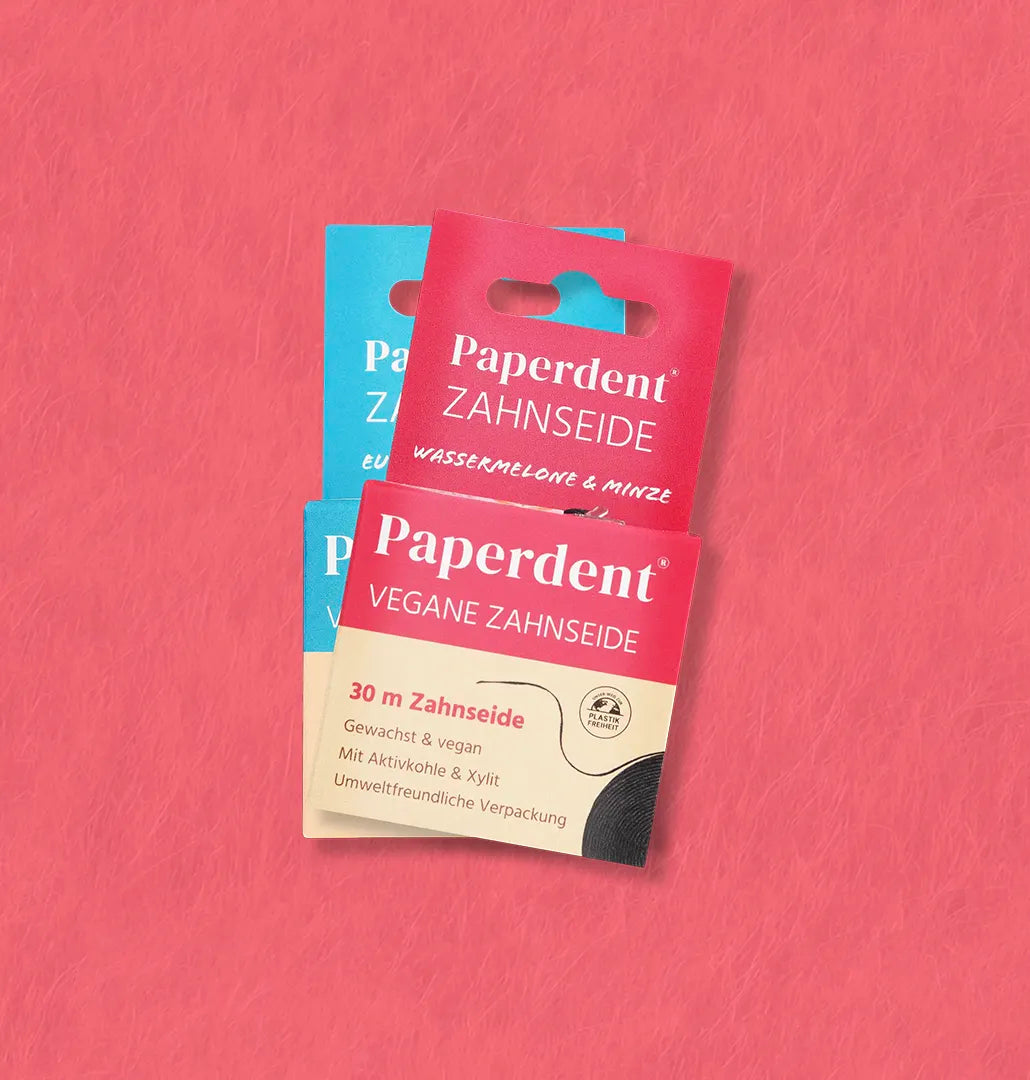
Vegan dental floss
Thanks to xylitol and activated charcoal, our dental floss is not only effective, but also invigorates with two fruity-fresh flavors. 30 m of dental floss are packed in a sustainable, compostable bioplastic bag made of wood pulp and are also vegan thanks to the microcrystalline wax used.
Dental floss FAQs
Unfortunately, when brushing your teeth, the spaces between your teeth can only be cleaned to a limited extent, as the toothbrush only reaches 70% of your tooth surface. By cleaning with dental floss, you remove leftover food and plaque that your toothbrush cannot reach. This will prevent tooth decay or plaque from forming between your teeth.
You should use dental floss at least once a day, preferably in the evening before brushing your teeth. The detached plaque is then brushed out of the interdental space by the toothbrush in this order.
It is best to use the dental floss in the evening before brushing your teeth. Take a long piece of dental floss and wrap the ends around your fingers. There should now be a piece about 5-10 cm long between your fingers. Now stretch this and insert it into the interdental space. To clean the interdental space, just move the thread up and down. Then you can wrap the dental floss a bit further so that you can use a clean piece of dental floss for the next interdental space.
Bleeding gums are a sign of inflammation. When your gums are inflamed, they have increased blood flow, become swollen, and bleed on contact. This means that these areas require a particularly high level of care. Bleeding gums can also occur if you apply too much pressure when cleaning and is not that bad at first. However, if your gums bleed after every cleaning and even with slight pressure with dental floss, you should clarify the cause with your dentist.
The used dental floss goes in the residual waste, the paper packaging in the paper waste and the bioplastic bag in the yellow bag. However, to be sure, check your city or county's guidelines or contact your local waste disposal service.
It is best to only use each thread of dental floss once. The aim is primarily to mechanically loosen plaque, i.e. bacterial accumulations. This works better the fresher the piece of dental floss is. So that the bacteria that have been brought out are not carried back into the interdental space, you should use an unused piece of your dental floss for each interdental space.
Bleeding gums may occur just at the beginning of the application. However, this is not a problem and should usually stop after a few days. If the bleeding continues, you should go to your dentist to clarify the cause, just to be on the safe side.
It depends entirely on your individual interdental spaces, whether dental floss or an interdental brush is more suitable. If the interdental spaces are quite large, the interdental brush is usually better cleaned. By choosing different sizes, you can achieve the best cleaning performance. In the case of very narrow interdental spaces, into which even the smallest size interdental brush cannot be inserted, sometimes only dental floss can be used.
Do you have any questions?
...then write to us!

